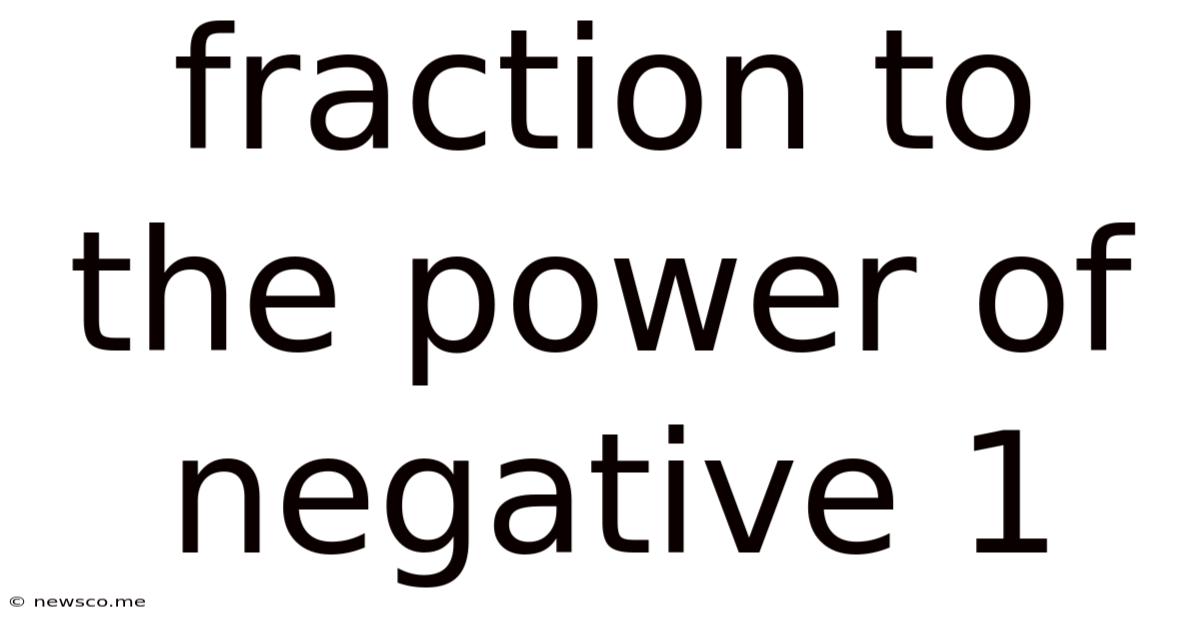Fraction To The Power Of Negative 1
News Co
Apr 24, 2025 · 5 min read

Table of Contents
Fraction to the Power of Negative One: A Comprehensive Guide
Understanding fractions raised to the power of negative one is crucial for mastering algebraic manipulations and solving various mathematical problems. This comprehensive guide will delve into the intricacies of this concept, providing clear explanations, practical examples, and helpful tips to solidify your understanding. We'll explore the underlying principles, address common misconceptions, and provide you with the tools to confidently handle such calculations.
What Does a Negative Exponent Mean?
Before tackling fractions specifically, let's establish a firm grasp on negative exponents. In essence, a negative exponent indicates a reciprocal. For any non-zero number 'a' and any integer 'n', the rule is:
a<sup>-n</sup> = 1/a<sup>n</sup>
This means that raising a number to a negative power is equivalent to finding the reciprocal of the number raised to the positive power. For instance:
- 2<sup>-3</sup> = 1/2<sup>3</sup> = 1/8
- 5<sup>-2</sup> = 1/5<sup>2</sup> = 1/25
- (1/3)<sup>-1</sup> = 1/(1/3) = 3
This rule applies to all numbers, including fractions.
Fractions to the Power of Negative One: The Reciprocal
When a fraction is raised to the power of -1, the result is its reciprocal. The reciprocal of a fraction is obtained by simply swapping the numerator and the denominator. Let's illustrate this:
Let's consider a fraction a/b, where 'a' and 'b' are non-zero numbers:
(a/b)<sup>-1</sup> = 1/(a/b) = b/a
Example 1:
(2/5)<sup>-1</sup> = 5/2
Example 2:
(7/3)<sup>-1</sup> = 3/7
Example 3:
(1/4)<sup>-1</sup> = 4/1 = 4
This simple rule forms the cornerstone of handling fractions raised to the power of -1. The negative exponent essentially "flips" the fraction.
Understanding the Logic: Why does this work?
The rule for negative exponents stems from the fundamental properties of exponents. Recall the rule for dividing exponents with the same base:
a<sup>m</sup> / a<sup>n</sup> = a<sup>(m-n)</sup>
Let's apply this to a specific case. Consider the fraction a/b raised to the power of 1:
(a/b)<sup>1</sup> = a/b
Now let's raise the fraction to the power of -1 using the exponent rule above:
(a/b)<sup>1</sup> / (a/b)<sup>2</sup> = (a/b)<sup>(1-2)</sup> = (a/b)<sup>-1</sup>
Simplifying this expression gives us:
(a/b)<sup>-1</sup> = b/a
This derivation elegantly explains why the reciprocal rule works for negative exponents with fractions.
Dealing with More Complex Fractions
The concept extends beyond simple fractions. We can also apply this to more complex fractions involving variables or expressions.
Example 4:
[(x+2)/(x-1)]<sup>-1</sup> = (x-1)/(x+2)
Example 5:
[(3x² + 5)/(2x - 7)]<sup>-1</sup> = (2x - 7)/(3x² + 5)
In these cases, the entire numerator and denominator are swapped to find the reciprocal. It's crucial to maintain the parentheses to ensure that the entire expression is treated as a single unit when taking the reciprocal.
Common Mistakes to Avoid
One of the most common mistakes when dealing with negative exponents is forgetting to apply the reciprocal to the entire fraction. It's crucial to ensure that the entire fraction is flipped, not just the numerator or denominator individually.
Incorrect: (2/3)<sup>-1</sup> = 2/-3 (This is wrong)
Correct: (2/3)<sup>-1</sup> = 3/2
Another common error involves misinterpreting the negative exponent as a negative value. The negative exponent merely indicates the reciprocal; it does not change the sign of the fraction.
Applications in Real-world Problems
The concept of a fraction to the power of negative one finds applications across various fields:
-
Physics: Calculating resistances in parallel circuits requires finding the reciprocal of resistances which can be effectively computed using this method.
-
Chemistry: Concentration calculations often involve using reciprocals of quantities, where the negative exponent becomes relevant.
-
Finance: Discounting future cash flows involves the use of reciprocals which can be written using negative exponents.
-
Computer Science: Inverted indexes and graph traversal algorithms frequently employ the concept of reciprocal relationships.
Beyond the Power of -1: Extending the Concept
While this guide focuses on fractions raised to the power of -1, understanding this foundation allows you to tackle more complex exponents. Remember that the same principle of reciprocation extends to other negative integer exponents:
(a/b)<sup>-n</sup> = (b/a)<sup>n</sup>
This means that you can flip the fraction and raise it to the positive power. For example:
(2/3)<sup>-2</sup> = (3/2)<sup>2</sup> = 9/4
Practical Exercises
To solidify your understanding, try these practice problems:
- (4/7)<sup>-1</sup> = ?
- (5/2)<sup>-1</sup> = ?
- [(x-3)/(x+5)]<sup>-1</sup> = ?
- [(2y²+1)/(y-4)]<sup>-1</sup> = ?
- (3/8)<sup>-2</sup> = ?
Answer Key:
- 7/4
- 2/5
- (x+5)/(x-3)
- (y-4)/(2y²+1)
- 64/9
Conclusion: Mastering Fractions and Negative Exponents
Mastering the concept of a fraction raised to the power of negative one is a significant step towards a deeper understanding of algebra and its applications. By understanding the principles explained here, and by practicing with examples, you can confidently handle these calculations and apply them in various mathematical contexts. Remember to take your time, focus on understanding the underlying concepts, and don't hesitate to review the materials to reinforce your knowledge. This seemingly simple concept forms the basis for more complex mathematical operations, making it a fundamental building block in your mathematical journey.
Latest Posts
Related Post
Thank you for visiting our website which covers about Fraction To The Power Of Negative 1 . We hope the information provided has been useful to you. Feel free to contact us if you have any questions or need further assistance. See you next time and don't miss to bookmark.